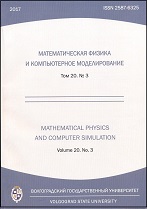|
This article is cited in 2 scientific papers (total in 2 papers)
Mathematics
The construction of the triangulation of plane domains by grinding method
A. A. Klyachin
Volgograd State University
Abstract:
Currently triangulation method is widely used in a variety of computational problems.
The reason for this is that the triangles are the simplest flat shapes, geometric characteristics of which are easy enough to calculate, and at the same time, any domain and even the surface approximated by triangles with the required accuracy. Therefore, the demanded problem is to develop triangulation algorithms areas which do not require a lot of time to perform and not expend a large amount of computer resources. In this paper we describe one approach to constructing a triangulation of arbitrary planar domains and give an assessment of the minimum angle triangles under certain geometric conditions.
First, we consider the small number of points of $ \overline {\Omega} $ and one of the algorithms build on them start triangulation. Further constructed triangulation undergoes grinding to reduce the fineness of the partition and hence improve the accuracy of calculations on it. Note that as the numerical characteristics responsible for the quality of the triangulation, we consider the minimum sine triangulation angles of triangles. Each triangle is divided into $q^2$ triangles.
We now denote by $\theta$ minimum angle of all triangles $\tilde T_k$. Further, for each of the triangle defined by the respective permanent $l_k, L_k $. These values define the boundaries of the domain $\Omega$. We introduce the notation
$$
l = \min_{1 \leq k \leq N_2} l_k, \ \ L = \max_ {1 \leq k \leq N_2} L_k
$$
Theorem 1. Minimum angle $ \alpha_q $, built triangulation for any natural number $q$, satisfies
$$
\sin \alpha_q \geq \frac {\sin \theta} {1+ | \cos \theta |} \frac {l} {\sqrt {1 + 4L^2} \sqrt{1 + 9L^2}}.
$$
Keywords:
triangulation, the triangle, the minimum angle of triangulation, splitting domain, Lipschitz condition.
Citation:
A. A. Klyachin, “The construction of the triangulation of plane domains by grinding method”, Vestnik Volgogradskogo gosudarstvennogo universiteta. Seriya 1. Mathematica. Physica, 2017, no. 2(39), 18–28
Linking options:
https://www.mathnet.ru/eng/vvgum169 https://www.mathnet.ru/eng/vvgum/y2017/i2/p18
|

| Statistics & downloads: |
| Abstract page: | 333 | | Full-text PDF : | 392 | | References: | 50 |
|




 Contact us:
Contact us: Terms of Use
Terms of Use
 Registration to the website
Registration to the website Logotypes
Logotypes








 Citation in format
Citation in format 
